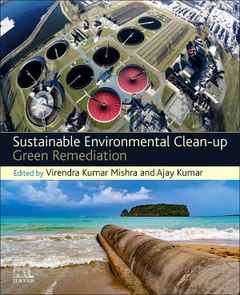Sustainable Environmental Clean-up Green Remediation
Coordonnateurs : Mishra Virendra Kumar, Kumar Ajay

Sustainable Environmental Clean-up: Green Remediation includes some natural, clean, and eco-sustainable technologies that have undergone the process of gradual development in past few decades. These technologies include a range of innovative natural and viable materials and offer a clean solution of environmental pollution. It includes case studies of phytoremediation, bioremediation (microbial removal of pollutant), constructed wetlands, natural media filtration for the sustainable environmental cleanup. Sustainable Environmental Clean-up: Green Remediation includes coverage of: Recent trends in eco-sustainable green remediation, Role of constructed wetlands in green remediation, Factor responsible for biodegradation of organic pollutants, Remediation through natural media (Sand, gravel, stope-chips), Microbes and their role in green remediation.
1. Green remediation basic concept and scope of green remediation2. Environmentally sustainable pollution remediation technologies3. Green and innovative technologies for the treatment air, water, soil4. Water quality improvement through green remediation technologies5. Constructed wetlands for the treatment of sewage6. Removal of emerging contaminants through constructed wetland7. Removal of pollutants from drinking water through natural and innovative filter media8. Bioremediation of organic contaminants through beneficial microbes9. Factor responsible for biodegradation of organic pollutants10. Plant growth promoting bacteria and its role in green remediation11. Entophytic microbes in abiotic stress management12. Fungi and environmental clean-up13. Cyanobacteria and their role in green remediation14. Biodegradation of Dye using beneficial microbes15. Microbial Bio surfactant/Microbial enzymes in the management of Organic waste
Dr. Ajay Kumar is a Professor at the Amity Institute of Biotechnology in India. He has published extensively in leading International and National journals or books. He has wide area of research experience, especially in the field of Plant-Microbe Interactions, Microbial biocontrol, and Endophytes related with the medicinal plants, Postharvest management of fruits. Dr. Kumar has published more than 165 research articles including review papers/book chapters/ books in the leading international journals. He is serving as special issue editors in some journals like “Frontiers in Microbiology, Microorganism etc. In addition also acting as reviewer in some leading journals like Frontiers group, PLOS ONE, Agriculture, Ecosystem and Environment, International Journal of Molecular Sciences, Biological Control, Plant Biochemistry and Biotechnology, 3Biotech etc. Dr, Kumar has edited several books with leading publishers including Elsevier, Springer, and Taylor and Francis.
- Presents recent trends in eco-sustainable green remediation
- Covers the role of constructed wetlands in green remediation
- Outlines the factors responsible for biodegradation of organic pollutants
- Discusses remediation through natural media (Sand, gravel, stope-chips)
- Explains microbes and their role in green remediation
- Includes the role of endophytic microbes in organic contamination management
Date de parution : 05-2021
Ouvrage de 356 p.
19x23.3 cm
Thème de Sustainable Environmental Clean-up :
Mots-clés :
AM fungi; biodegradation; bioemulsifiers; biogenic nanomaterials; bioremediation; bioslurping; biosorption; biosparging; bioventing; constructed wetland; constructed wetlands system; cyanobacteria; emerging contaminants; environment; food contamination; fouling; green synthesis; green technology; health hazard; heavy metals; impact assessment; industrialization; insecticides and pesticides; membrane; microbes; microbial biosurfactants; microbial degradation; microbial metabolism; nanocatalyst; nanocomposite; nanoparticle; natural treatment technology; organic contaminants; organic pollutants; organic waste; PGPB; phycoremediation; physicochemical; phytoremediation; plant growth–promoting bacteria (PGPB); pollutants; pollution; polymer; radionuclides; remediation; removal; sewage; soil pollution; surface-active compounds; sustainability; sustainable methods; synthetic fertilizers; technologies; urbanization; wastewater; wastewater treatment; water pollution; water purification; xenobiotics



